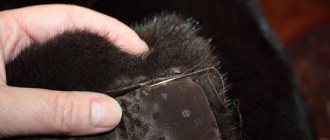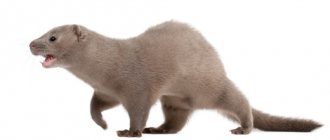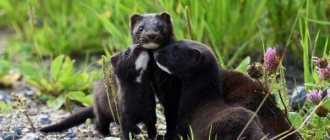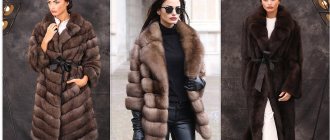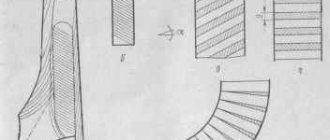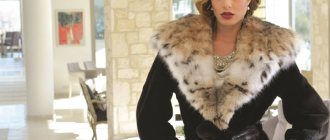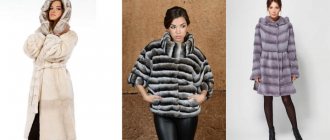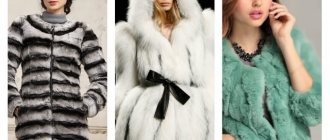Can a fur coat be inexpensive and what fur coats are the cheapest? Every woman wants to save money, but at the same time buy a truly high-quality item.
Fur coats have been and remain the best option for winter outerwear for our harsh winters, and products made from natural fur will keep you warm much better than their artificial substitute. Every woman understands this and therefore the demand for natural fur coats remains high, as does their price.
There are some tricks, using them, you can buy a really good product, but at a lower price.
Rabbit fur coat
Classifications of types of fur: professionals versus buyers
For the vast majority, fur is divided into “wolves”, “hares”, “mouton” and so on. Professionals are horrified by this, because this is the most meager description that can be given. In fact, all furs are divided into several groups according to the length of the hair and the origin of the skin. Let's take a closer look at them.
By hair length
All products can be divided into:
- Low-haired.
These are skins with hair lengths up to 23 or 25 mm. The most striking representative of this species is the mink.
Mink fur is very dense and smooth
- Medium-haired.
Here the hair length should be up to 50 mm, like that of a sable or marten.
Pay attention to the underpads. Its height is usually 30 mm
- Long haired.
Hairs from 50 mm, quite dense and smooth. For example, like the raccoon and silver fox.
At the same time, the hairs are evenly colored and of the same length
How is this useful for the buyer?
It's simple: the shorter the hair, the more soft down it contains, which ensures maximum heat retention. That is, a mink coat will be warmer than a sable product.
But this does not mean that you should not pay attention to long-haired skins. Many of them have naturally very warm fur (like wolves and raccoons). Only aesthetics play a role here. Fur coats with long, voluminous fur will look better on thin and tall girls than on ladies with curvy figures.
Now let's move on.
By origin
They are divided into groups of animals from which the skins are obtained. That is, there is fur:
- mustelids
(ermine, mink, sable and marten); - canids
(wolf, fox, arctic fox); - lagomorphs
(hare); - felines
(lynx, etc.); - rodents
(squirrel, chinchilla).
Sheepskin is always placed in a separate category.
It is quite difficult to give a general description of each group. Because wolf fur, for example, is very different from fox fur, not only in appearance, but also in technical characteristics: the degree of warmth and shedding.
Of course, many furs differ from each other visually, but you need to check yourself when choosing
It is important to distinguish them in order not to stumble upon a fake or waste money down the drain. So the fur of a hare can be passed off as mink or sable (you will overpay three times). But investing in squirrel is generally unprofitable; products made from it are not durable, shed heavily and quickly lose their presentation even with the most careful handling.
We propose to consider each type of fur separately, so that after reading you can decide which product you need.
Mink coat and its features
This option, such as a mink coat, is the most popular. Many women prefer this type of fur because of its versatility. Firstly, mink fur has average heat resistance and wear resistance, secondly, a mink coat can last quite a long time - up to 10 seasons, and thirdly, the cost of this fur coat is low.
The fur of a male mink is much warmer than that of a female because it has a thick, dense undercoat that keeps the cold out. However, the second option may also turn out to be warm, it all depends on the model of the fur coat and the type of fur treatment. For example, on sale now you can see a mink coat with fur in the same form as it was originally, and there are plucked and shorn models.
To create a plucked mink, the longest hairs are pulled out, giving the fur a plush appearance. A plucked mink coat will be less warm, but the sheared model has even less heat-resistant properties, since the fur processing technology involves cutting not only long hairs, but also short pile. By the way, the latter processing method is often used when there are defects on the product, so when choosing a fur coat, take this into account.
Brief overview of furs
Sable
Belongs to the mustelidae family. Warm, wearable, used for sewing both classic fur coats in natural colors and trendy models. Products made from it are considered the most expensive.
The price of the product varies depending on the color. The more gray hair it has, the more expensive it is. For example, a classic fur coat up to 90 cm long will cost $5,500 or more.
We offer “gray-haired” sable to lovers of the classics in an unusual design
Marten
If sable products are too expensive for you, pay attention to marten. This fur is more wearable, although its hairs are slightly shorter. It is often tinted to resemble sable, so non-professionals will not notice any difference.
You can choose fur coats of the most unusual colors. Due to its light natural undertone, marten is easier to tint
Mink
It is considered the most popular on the market due to its technical characteristics: wears well, is very warm for medium hair length (up to 40 mm), dyes well. Available in dozens of shades.
Mink in natural colors is much cheaper than green or, for example, red. Why? The fact is that dyeing is an additional technological process that increases the cost of skins used for sewing
Lynx
Elite fur. Warm, wearable, difficult to care for. It is believed that the brighter the black spots stand out against a light background, the better the quality of the skin and the higher the price. For exclusive products, there is another criterion: the more white there is in a fur coat, the more expensive it is. Lynxes have white fur only on their tummies, so the material consumption is enormous.
The price varies from $2,000 for a regular product and 18–25,000 for an elite one.
White lynx fur coats are elite products. We use Canadian lynx fur to sew them.
Chinchilla
The most unwearable of all, does not hold heat well. Even the most expensive product will not last more than three seasons if worn infrequently. You should buy something made from chinchilla only if you need a fur coat “for going out” or for a collection (the second or third in your wardrobe).
Prices range from $3,000 to $5,000 for a short piece and $6,000 for a long piece.
Such products are very voluminous and are suitable mainly for fragile girls.
Rabbit
Nenosky fur with hairs of medium length. Does not last more than two seasons due to the structure of hair (as well as protein). Starts to shed quickly.
Unscrupulous sellers often pass off a rabbit as a chinchilla. It is very easy to uncover a fraud. Run your hand in the direction of hair growth on the skin. If the fur is slightly cool on the hand, it’s a chinchilla; if not, it’s a rabbit.
Fox
Warm fur with very long hair. Warms at an average level, but may shed if not cared for properly. Fur coats are rarely made from it because the products are too bulky.
The price ranges from $600 per vest depending on the color of the fur and the consumption of the pelts.
Fox fur can be chosen depending on your color type or personal preferences. It is believed that the silver fox looks more presentable
Arctic fox or arctic fox
Incredibly warm fur with very long hair up to 80 mm, dense down. Will keep you warm in the coldest winter. Capricious in care. It cannot be called wearable. Very voluminous, rare and expensive.
Fur coats are very rarely made from arctic fox, as the products are too expensive. You can only buy vests from us
Wolf
Classic coarse and long-haired fur. Used for sewing men's models or in combination with leather. Long fur coats are not made from it; they turn out to be very bulky and uncomfortable to wear.
Typically, wolf fur is used only for insulation of men's sheepskin coats or for their decorative finishing.
Raccoon
Warm and voluminous fur with very long hair. Products made from it are incredibly warm and wearable - raccoon fur is never eaten by moths. It does not require special care.
At the same time, its price is affordable. The fur coat will cost from $700.
Raccoon fur coats are the warmest
How to care for a fur coat?
If you do choose a successful option, you need to make sure that the product serves you for as long as possible. You need to know how to properly care for such a thing. It is recommended to hang your fur coat on hangers that suit your size, and it is advisable that they have a wider brim. Ideally, a fur coat should be in a case and stored in a closed closet away from heating appliances. If you choose a dyed fur coat, it is not recommended to hang it next to light-colored items to prevent them from staining.
It is not recommended to clean fur yourself at home; it is better to contact a dry cleaning specialist. If your fur coat gets a little wet under the snow, it can be easily dried. To do this, you must first shake the product thoroughly, then spread it out in an even layer on any horizontal plane (for example, on the floor). The fur coat should be left to dry at room temperature; under no circumstances should the product be placed next to a radiator or any other heating device. After the fur coat has completely dried, the fur should be combed with a brush in the direction of the pile.
Considering the high cost, you need to know how to choose the right fur coat. Follow the tips above and take your time making your purchasing decision.
So what should you choose?
Never take products made from rabbit or squirrel. This is a waste of money. After a season or two they will fade and lose their presentation.
Consider the rest depending on your budget, regional climate and level of wear, as well as your figure. So, a raccoon will survive anything, but is only suitable for a very cold winter. Plus it can fill you up a lot. Sable, mink and arctic fox are less warm, but have more status - eternal classics. Suitable for mid-zone climates. Products with wolf fur are considered purely masculine, and those made with chinchilla are considered impractical.
In any case, ask sellers to show the inside of the product under the lining. In a high-quality product, it is not sewn tightly, that is, there should be a large slot or a special zipper inside. Only in this way will the buyer be able to evaluate the quality of the leather, feel its softness, and check whether it is stretched. We provide this opportunity in our store, as we are completely confident in the quality of the product.
Now you know all the most important things about fur. We hope the article was useful to you. In the next one we will talk in detail about how to choose a quality fur coat yourself.
